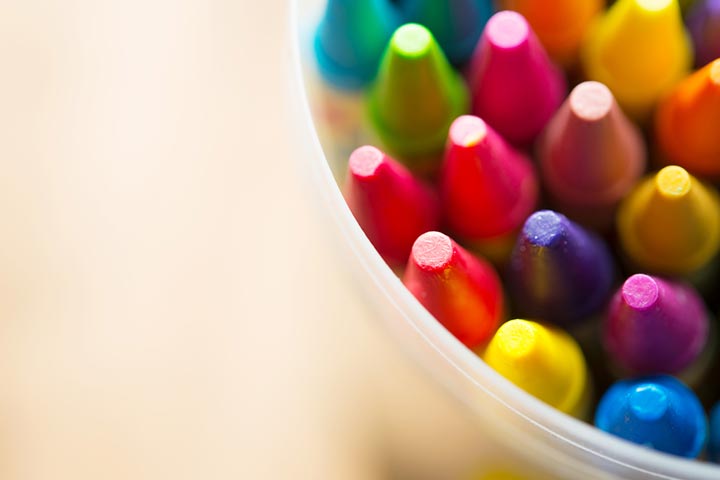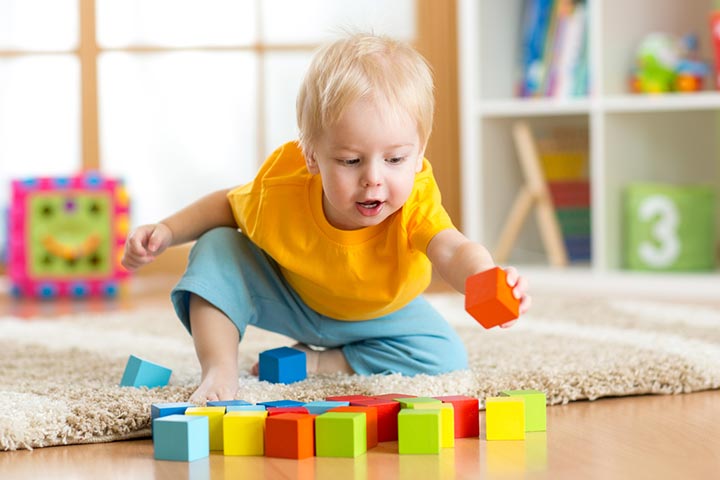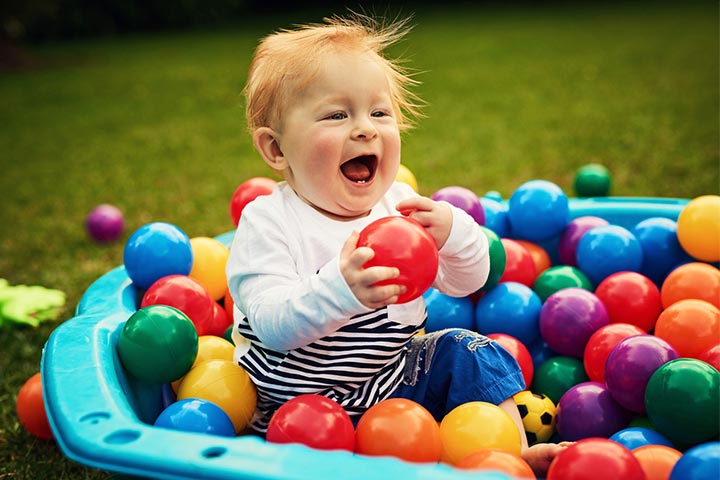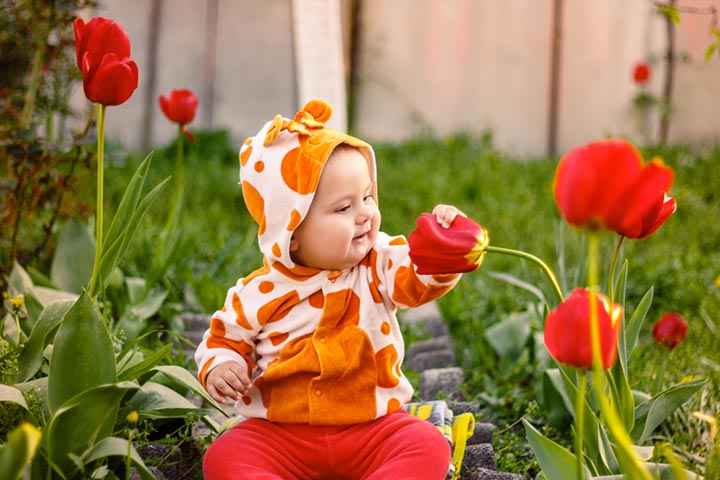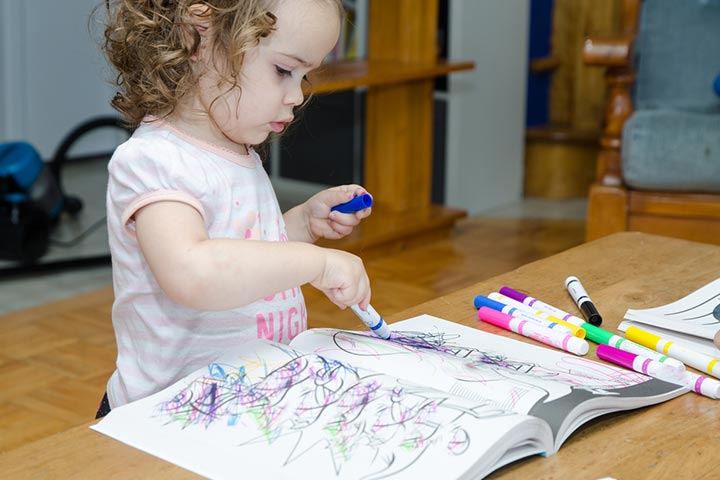Colors fascinate babies. The ability to identify colors is a milestone of their cognitive development. Most toddlers start differentiating colors by the age of 18 months. However, their ability to name different colors can develop by 36 months (1).
That said, you may start introducing colors to your children whenever you feel they are ready because the ability to learn and perceive varies from one child to another. You can teach colors by pointing out various objects in their environment— indoors or outdoors.
However, it is important to note that identifying and naming colors or hues is a visual differentiation skill that takes time to develop. Connecting various items in the surroundings with their colors can be confusing for toddlers, and the skill only evolves with observation and practice (2) (3).
Keep reading this post to know about the benefits of learning colors for toddlers and how you can teach them.
Benefits Of Teaching Colors To Toddlers
Learning colors from a young age may have several benefits for toddlers. Some of these are:
- Learning colors helps toddlers to develop cognitive, mental, and creative skills (4).
- Toddlers learn to make connections through colors; for example, green can be associated with raw banana, while yellow with a ripe one.
- Color palette recognition enhances the language skills of toddlers. As they learn to identify and name the colors, they can express themselves better.
- Knowledge of colors enhances mathematical skills that involve logic, sorting, comparing, organizing, and matching (5).
- Certain color activities may also help in relaxing and de-stressing toddlers with behavioral issues (6).
- Exploring and understanding colors can make toddlers better learners by improving their attention span (6) (7).
First Colors You Can Introduce To Toddlers
Toddlers get attracted to bright colors, so it is good to introduce colors, such as red, blue, green, and yellow (6). Most babies start differentiating between red and green colors by the time they are three or four months old (8).
You may decorate your children’s rooms using these colors or buy them toys and books that are bright.
Tips To Remember While Introducing Colors To Toddlers
Teaching colors to toddlers might take time and patience. However, some that you should remember before teaching colors are:
- Children have different understanding capabilities, and you should design activities based on your child’s needs.
- Introduce only one or two colors at one time and continue teaching about them until your child can easily recall them.
- Do not rush with any activity related to color. Give toddlers adequate time to observe, understand and explore.
- Keep exposing toddlers to colorful objects or prints. More practice will help them retain the concept of color better.
- Illustrate colors through everyday activities. This will help children understand the concept faster.
- Introduce contrasting colors at the beginning, such as red and yellow or green and blue. If you emphasize colors of the same family, such as red and orange, toddlers might get confused.
Ways To Teach Colors To Toddlers
Teaching colors to toddlers is not always challenging. But when you introduce colors through fun activities, they can understand it better. Here are ten different ways to teach colors to your toddlers.
1. Serve a platter of colorful meal
- Involve your toddlers while cooking or preparing meals.
- Point out to them the colors of each item that you use in preparing the meal.
- Serve colorful salads on their plates, such as tomatoes, cucumbers, or carrots.
- While eating, ask children the color of each food item on their plates.
- This simple activity may help children understand colors and their food better.
2. Compare two identical objects of different colors
- Comparing is an important pre-math concept.
- While teaching more than one color, compare two identical objects of different colors.
- For example, if you want your toddlers to differentiate between blue and yellow colors, show them two identical balls of blue and yellow color. If you show a blue ball and a yellow fruit, children may get confused.
3. Sort objects by color
- Give similar objects (pom poms or small balls) of different colors to your toddlers.
- Encourage them to sort these objects into different groups based on their colors.
- Then, have them place the sorted objects in the same color cup.
- Initially, your toddlers may need your help doing this exercise.
4. Match the same colors
- Most children enjoy color matching activities.
- This can be a great activity for toddlers who are just starting to learn colors.
- You may introduce the color-matching activity through stickers, colored popsicle sticks, different color shapes, or color-matching puzzles.
- You may even play dress-up and wear a matching-colored outfit to add more fun to the activity.
Christy, a homeschooling mother of four, shares an exciting and fun way of teaching colors to her son in her YouTube video. She makes colored puppets and bowls and asks her son to sort them by matching the blue-colored puppet to the blue-colored bowl and so on. Christy says a sorting activity like this can be a great way to learn colors for toddlers (i).
5. Paint with hands
- Toddlers enjoy painting with their hands.
- Utilize this opportunity to introduce colors to them.
- Give them a piece of paper and some paint (preferably one color) and let them unleash their inner artist.
- Hand painting gives children an opportunity to feel the paint, visualize and explore the color. This activity may also help in enhancing their sensory skills.
6. Explore nature
- Nature is a treasure of colors.
- Go outdoors with your toddlers for a color hunt.
- Point out different objects and introduce their colors to your children. You may use colorful flowers, green leaves, and grass to indicate colors.
- This is an interesting way to teach colors to children as they can beautifully connect with nature.
7. Sing a song
- Children can connect through music, so it is a good idea to teach colors through songs.
- Play color songs for them.
- Have fun singing and dancing together.
- Point out the colors in these songs while singing them.
8. Recognize colors in books
- Buy books that are big, bright, and colorful. Alternatively, you could even create books of colors at home by cutting out large pictures and binding them together.
- As both of you read books together, show the colors in it.
- This is a fun idea that may help children retain the concept of colors.
Learning colors becomes more exciting with books. Christy explains an interesting activity she created for her son based on the book The Crayon Box That Talked. She says, “After we read the book together, I gave each of us a piece of copy paper and a small box of crayons. We drew pictures on our papers using all of the colors. As we drew, I would occasionally ask my son what color he was using, point to ones he already used and ask him what colors he used. A very easy activity, but one my little guy just loved! We’ve repeated it several times at his request (ii).”
9. Practice with coloring books
- The simplest and the most common way in which toddlers practice colors is through coloring books.
- Coloring books come for all ages.
- Choose the one that suits your child.
- Coloring activity improves motor skills, enhances creativity, develops focus and hand-eye coordination, and relieves stress (9).
10. Color mixing
- Once toddlers are thorough with learning primary colors, it is time to move to secondary colors.
- Color mixing is a great activity for children to understand how secondary colors are created by mixing primary colors.
- There are many color mixing activities that you can plan with them.
- One such activity is to make a color mixing jar. First, in a plastic jar, put some shaving cream and marbles. Then, ask your child to add two primary colors and shake the jar.
- Slowly, the colors in the jar start mixing, and it is fun to watch the change in colors.
11. Color bath
- Bath time can be utilized effectively for teaching colors.
- Add a few drops of food-grade color to your child’s bath water and let them identify the colors.
- Change the color each day and let them identify it.
- Alternatively, you can add waterproof toys of a single color to your child’s bathtub for a fun experience.
12. Color puzzle
- These puzzles may be purchased, or you may make them yourselves.
- Cut out similar shapes from a piece of cardboard so that the pieces may be set again in the designated holes.
- Stick a label with the name of the color on the holes and color the cut-outs.
- Ask your child to place the cut-outs in the labeled holes.
Learning colors for toddlers help in their cognitive, language, and visual development. So if your child has reached the right age of learning colors, you can use the above activities to teach them better. These activities will help them differentiate colors, relate them to the objects, and improve their motor skills. So get started with teaching colors and let them learn at their own pace. Also, make it a fun experience and use it as an opportunity to strengthen your bond with your children.
Key Pointers
- Babies usually easily identify basic colors, such as green and red, by the age of four months.
- Teaching color to children depends on their learning abilities and can aid their cognitive and language development as they try to differentiate and name the colors.
- Things like matching and sorting different-colored objects or singing a song about colors can help them remember colors.
Watch as toddlers embark on an adventurous journey to learn colors through exciting crayon surprises! Witness their exploration of the colorful world in this delightful and educational video!

